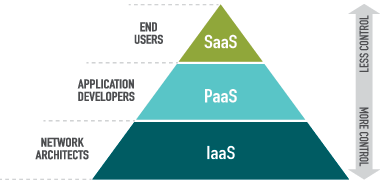Cloud computing is becoming increasingly-common in business, with online software and applications revolutionising the way we work – from communicating to file sharing. And, as part of our evolution towards becoming cloud native, a huge contributor is the rise of SaaS. But what exactly is ‘software as a service’?
In this article, we’ve delved into what SaaS technology actually is – including how it works and real-world examples – as well as the benefits of SaaS and why it might be right for your business.
What is software as a service in business?
Software as a service for business can be summarised as being a piece of software or online application hosted over the web, and is best visualised as sitting at the top of a three-tier cloud computing pyramid that also comprises:
- PaaS (Platform as a Service) in the middle
- IaaS (Infrastructure as a Service) at the bottom
The amount of customer control over the virtualised IT resources increases as you descend the pyramid.
If you’re interested in learning more about the differences between the different types of cloud services, explore our guide to SaaS vs PaaS vs IaaS.
How does SaaS work?
SaaS is a software distribution model in which applications are hosted by a vendor or third-party service provider, and made available to customers over a network, typically the Internet.
SaaS is often referred to as software on demand, and the simplest interpretation is that this is software you rent, rather than buy. Popular payment models include:
- Subscriptions
- Annual and perpetual licences
- Rentals
- Payments after use
The evolution of SaaS
SaaS has grown significantly over the last few years, due to both consumers’ and businesses’ accelerating-demand for quick and affordable access to online applications that were previously either financially or physically inaccessible.
That dynamism is only set to continue with users becoming ever-more mobile, and vendors pushing towards delivering increasingly-cloud-native applications. In turn, we’ll inevitable relegate ‘cloudified’ client/service architectures in place of new levels of enterprise automation – with its ability to support more agile, connected business activities.
Real-world SaaS examples
The chances are you regularly engage with real-world examples of SaaS companies on a weekly (if not daily) basis. For instance, common SaaS technologies include:
- Video calling technology (such as Microsoft Teams and Zoom)
- Instant chat software (such as Slack and Microsoft Teams)
- File sharing SaaS platforms (such as Dropbox and Google Drive)
What are the benefits of SaaS?
With its ability to offer affordable, scalable and instant access to a huge range of enterprise software, SaaS can:
- Reduce upfront costs: The SaaS business model allows organisations to invest in applications without upfront capital – freeing up resources to use elsewhere.
- Fast implementation: Underpin rapid implementation through a cloud deployment model. Significantly improve business organisation and agility through fast provisioning.
- Effective planning: The predictable pay-as-you-go model of SaaS allows you to plan and forecast with greater certainty. You know exactly how much you’ll be spending each month!
- Improve efficiency: Remove the need for internal resourcing, support and management of on-premise software. Cloud service software is handled by the provider, so you don’t need to worry about maintenance.
- Increase productivity: Encourage more positive adoption and greater value return, thanks to frequently lower learning curves associated with browser access.
- Introduce integration: SaaS effectively and efficiently facilitates integration and connectivity between systems through freely available APIs
- Improve agility: Create a more mobile and productive workforce thanks to SaaS’ ‘work anywhere’ characteristics. Cloud software can be accessed anywhere with an internet connection.
- Enjoy competitive advantage: The introduction and growth of SaaS helps to level the playing field for smaller organisations who can now take advantage of enterprise applications without huge investment.
- Scalable commodity: Because you can quickly and easily scale cloud software up and down, depending on business needs, SaaS flexes in perfect alignment with user demand.
- Perennial refresh: Managed and maintained by your cloud service provider, rather than requiring internal IT resources, SaaS users always have access to the latest and most up-to-date version.
- Derisked development: SaaS and cloud software comes with little risk, compared to investing in local software, which makes for easier trialling and delivering proof of concept to stakeholders.
Is SaaS right for my business?
We’ve looked at how SaaS technology can benefit your business, and its various advantages – not least flexibility, scalability, and cost-effectiveness – but it’s important to also acknowledge that all companies are different, and there’s rarely a one size fits all solution when it comes to cloud computing.
With this in mind, if you’re still unsure whether SaaS fits into your business model, get in touch with one of our expert and experienced cloud consultants, who’ll be more than happy to provide bespoke and tailored advice centred around your current needs and plans for growth – as well as the SaaS advantages and disadvantages based on your circumstances, and whether you’d be better-suited to another cloud service.
Alternatively, explore even more advice over on our cloud blog, including ‘What is PaaS?’ and ‘What is IaaS?’.




